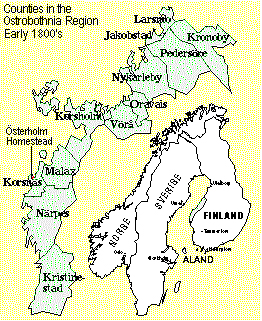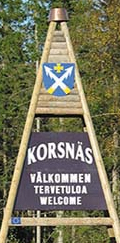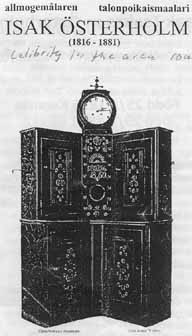|
|
Just over 200 families claim the surname Osterholm in the United States, many of whom are not related. Our family name comes from a 17th century Swedish homestead settlement in western Finland, called Österholm. Öster is Swedish for "One from the East," and holm means "island" or "peninsula."
 During Sweden's occupation of Finland from the
14th century to the beginning of the 19th century, thousands
of Swedes moved to the west coast of Finland, claimed land
and built Swedish speaking homesteads, many of which remain
today. A village had many homesteads or settlements
(usually farms). In those days settlers were typically
farmers, fishermen, hunters, craftsmen or soldiers.
Village farms consisted of various owners with separate
names. Farms or homesteads had numbers and names
allocated to them. This is where the origin of our
name is found. The homestead of Österholm (then
loosely translated as "settlers ground" or "settlers land"
in Finnish) was known as homestead number 12, located in
the village of Molpe, municipality of Korsnäs, region of
Ostrobothnia (see map on right). The Österholm
settlement eventually covered over 4 square miles.
Korsnäs is the westernmost municipality in Finland, and is
still 98% Swedish speaking in a dialect called
Ostrobothnian. The majority of emigrants from the late
1800s and early 1900s originated from the Ostrobothnia
region (Swedish is Österbotten, Finnish is Pohjanmaa),
now a province in Western Finland. Today, the
Österholm area is a suburb of the city of Molpe (Moikipää in
Finnish), about 1 mile east. Click
here to see a photo of a home built on the
homestead in the late 1800's.
During Sweden's occupation of Finland from the
14th century to the beginning of the 19th century, thousands
of Swedes moved to the west coast of Finland, claimed land
and built Swedish speaking homesteads, many of which remain
today. A village had many homesteads or settlements
(usually farms). In those days settlers were typically
farmers, fishermen, hunters, craftsmen or soldiers.
Village farms consisted of various owners with separate
names. Farms or homesteads had numbers and names
allocated to them. This is where the origin of our
name is found. The homestead of Österholm (then
loosely translated as "settlers ground" or "settlers land"
in Finnish) was known as homestead number 12, located in
the village of Molpe, municipality of Korsnäs, region of
Ostrobothnia (see map on right). The Österholm
settlement eventually covered over 4 square miles.
Korsnäs is the westernmost municipality in Finland, and is
still 98% Swedish speaking in a dialect called
Ostrobothnian. The majority of emigrants from the late
1800s and early 1900s originated from the Ostrobothnia
region (Swedish is Österbotten, Finnish is Pohjanmaa),
now a province in Western Finland. Today, the
Österholm area is a suburb of the city of Molpe (Moikipää in
Finnish), about 1 mile east. Click
here to see a photo of a home built on the
homestead in the late 1800's.
When a Swedish settler claimed a piece of land in a homestead or village in western Finland, that homestead or village would usually become the settler's surname. Often several families, not related, would assume the same surname, based upon their domiciles, such as a homestead. The implication was that a new last name would be acquired when moving to another homestead or village, which helped the Lutheran Church with census keeping. For example, our first known ancestral record comes from the village of Palo in the Ostrobothnia region of southwestern Finland. Records show Matts Hansson Palo, born about 1670, owned the Palo farm in the village of Palo, Isokyrö municipality (Storkyrö in Swedish). Then, palo in Finnish meant "burning" (today the word is palava), and the Swedish word for "burning" was brenner (also bränner or brännär, today is brännaren). Matts' children chose Brenner as their surname, the Swedish form of Palo. Matts' grandson, Isak Johansson Brenner, moved to the homestead of Österholm in a neighboring village, acquired land, established a farm, and subsequently took Österholm as his surname. Family members who lived in other homesteads or villages sometimes took different surnames (common in our own genealogy). By the mid-1800's, the government required one surname be used throughout a lifetime. Thus, we kept the name Österholm.
Note: Literally all surnames (family names) may be classified on the basis of their derivation in one or more of the four following groups in this order:
| 1. From Village Names or Landscape
Features (Place Names) 2. From the Father's Name or other Relationships (Patronymics or Matronymics) 3. From Occupation or Office (Occupational Names) 4. From Description of Action (Nicknames) |
 Isak
Johansson Brenner arrived in the village of Molpe at the
Österholm homestead in 1811 with his wife Maria Jakobsdotter
Ryssman and a son. They came from the neighboring
village of Laihia (Laihela in Finnish). Isak was 3rd
born of 9 children, the son of Johan Eriksson Brenner,
from the nearby village of Storkyro (Isokyrö in
Finnish). Isak took the name Österholm after settling
and subsequently claiming land in the homestead. If our
family were to have a coat of arms, likely we would have
adopted the crest of Korsnäs.
Isak
Johansson Brenner arrived in the village of Molpe at the
Österholm homestead in 1811 with his wife Maria Jakobsdotter
Ryssman and a son. They came from the neighboring
village of Laihia (Laihela in Finnish). Isak was 3rd
born of 9 children, the son of Johan Eriksson Brenner,
from the nearby village of Storkyro (Isokyrö in
Finnish). Isak took the name Österholm after settling
and subsequently claiming land in the homestead. If our
family were to have a coat of arms, likely we would have
adopted the crest of Korsnäs.
Records
state that Isak Johansson Brenner came to the Österholm
homestead as a "new builder" or "ground breaking settler,"
and that he "acquired a 3/16 area for a farm and home of
such a size that it could support a family and pay the
associated taxes." Twelve years later in 1823,
Isak got in trouble with the authorities. He was
"found guilty and whipped with a stick for housing criminals
and fighting with an ax." Isak had 12 children of
which only six survived more than 3 years. His
first born son, Jakob Isaksson Österholm, born in 1810, is
our ancestor. Jakob's brother, Isak Isaksson
Österholm, born in 1816, inherited the homestead (farm)
and became one of the most respected artisan furniture
makers of the 19th century Ostrobothnia region:
 |
The Swedish-speaking part of Ostrobothnia
is one of the most museum-dense areas in the world.
There are almost a hundred different museums and
collections reflecting the history of
Ostrobothnia. The Ostrobothnia museum in
Vaasa (also called the Österbottens museum
or the Pohjanmaan museo), a few miles north
of Molpe is home to some of Isak's works. A
booklet from the museum (see image of cover on
left), is entitled "Country Artisan, Isak
Österholm," which describes his life's work.
The inside of the booklet states, "Carpenter and
painter Isak Österholm is the most famous furniture
decorator from Swedish speaking Ostrobothnia in the
19th century...His operating circles consisted of
the Swedish speaking coastal region south of Vasa as
well as the villages in the archipelago," and "About
16% of all preserved furniture with painted
decorations from this area can be traced to be of
his hand." "He is known for his decorative
carvings in the churches of the region and he also
worked as a master builder on official construction
projects and repair assignments."
The booklet mentions more about Isak's craft, including "It is not known where and from whom he learned the art, but since he was able to write and well versed in the secrets of painting, it is likely that he has been an apprentice of a master. According to Isak's own account he was self taught in all the crafts he mastered." "The oldest known piece of Isak Österholm was found in Sundom (Vasa); a wall cabinet with a built in clock case and decorative paintings. The cabinet's composition of flowers are very similar to the type of decorations that Isak's contemporary colleague, Matts Sandelin, used." |
Many of Jakob's and Isak's descendants, just two generations later, would leave the west coast of Finland for America, during the great Scandinavian migration of the late 19th century. Jakob's great grandson, Carl (Charles) Fredric Österholm, left for America with his brothers in the late 1890's. Charles came through Montana, eventually settling in Washington State, where our family is today.
In Swedish, our surname literally means "One from the East Island" (öster/east) and (holm/island). It is possible the homestead of Österholm derived from a variation of Österlandet (Eastland), later translated into Finnish as "settlers land." During the Middle Ages, Swedes referred to Finland as the "East Island" or "East Land." In Sweden, the name Österholm probably originated in the same way Stockholm did. Stockholm, the capital of Sweden, is known as "the City between the Bridges," referring to its unique situation in the archipelago of more than 24,000 wooded and rocky islands connected with a lacework of waterways. Stock (log) holm (island) began as a city on a little island, now the Old Town, where the Baltic Sea and Lake Mälaren meet. The island soon became connected with the mainland by a system of bridges supported by logs, first named "Log Island" (Stockholm). In the same way, those residing on these islands off the east coast of Sweden, produced the name Österholm.
Finland
was
integrated
with the Swedish state from 1350 to 1809 when many Swedes
established homesteads in Western Finland. The first
significant Swedish population growth in Western Finland was
in the 1300's, most likely when our ancestors first arrived,
originally settling in the county of Korsnäs on the west
coast (see map above). Both Finnish and Swedish are
official languages in Finland, and several cities have both
a Swedish and Finnish name. Other Swedes settled on
the Åland Islands (click here
for info), another province of Finland. About 8% of
Finland's population speak Swedish.
Special thanks goes to Anne-May Österholm, Egil Österholm, Erik Sepanaho, Stefan Sepanaho, Kaj V. Norrback, Kalmi Riikka, Petri Hellemaa and others in Finland who have significantly contributed to this research effort.
|
|
|
Email
Updated 2/2013